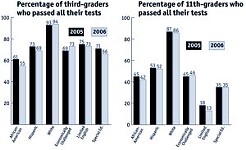Proposition 5: The Middle School at Edwards Aquifer
The controversy over the proposed Southwest middle school has a long history
By Rachel Proctor May, Fri., Aug. 27, 2004
But when the trustees released the final bond package, it included the $36 million school, to be located at Slaughter Lane and RR 1826, just outside the western boundary of the Edwards Aquifer recharge zone. The decision delighted southwest parents, who had spent months campaigning for the school, and dismayed some environmentalists, who saw the designated campus as a magnet for additional sprawl. (The insider chatter on the board decision has been marked by charges and counter-charges of special pleading and political blackmail, most specifically that some neighborhood groups threatened to organize against the entire bond package unless the southwest middle school was included.) Environmental advocates were particularly annoyed that the school was paired in a single proposition with the performing arts center. "I would very much like to vote for the performing arts center," Bill Bunch of SOS told a public forum on the bonds, "but I can't do so in good conscience as long as it's paired with the southwest middle school."
Trustees say they were just responding to the very latest demographic and planning data. The CBAC, after all, had been working on their recommendations for more than a year – long enough for many a subdivision to spring up in the southwest – and AISD's demographer, using new planning and permitting data from the city, had just finished a new report in April.
"Initially I opposed a new middle school in the southwest because the student growth data did not meet the 125% standard," said trustee John Fitzpatrick. "But we when got our updated demographic data, and new information on existing and planned development and housing, the numbers were well over 125%."
The new data did show Paredes Middle School at 160% of its capacity by 2008-9, and Bailey at 137%. However, the CBAC was aware of these projections when they made their final recommendations, and still said "no" – arguing that the excess capacity could be handled by boundary adjustments. Their position was supported by a April 21 memo written by Larry Throm, AISD's chief financial officer, and circulated by groups like the South Austin Democrats. "Unlike the north middle schools, the south middle schools have more than sufficient capacity to house those students in adjacent middle schools," Throm wrote. Those include Mendez at 82% capacity, Porter (72%), Bedichek (67%), and Covington (56%).
The trustees respond that boundary adjustments are an inadequate solution, because they oppose widespread busing, out of a commitment to neighborhood schools. But while such schools are a time-honored tradition at the elementary level, they generally are not during middle school. (Another factor in the board's position is the dramatic spike in the number of AISD students who leave the district – presumably for private or charter schools – between fifth and sixth grades.) In the case of the specific southwest location, trustees make the further environmental appeal that if the district does not use the designated patch of land – which will be both SOS-compliant and green-built – the developer, Stratus Properties Inc., will use it instead for apartments, bringing even more people over the aquifer.
"It's not a question of whether that tract will be developed, it's how and when," says District 7 (Southwest) trustee Robert Schneider.
Those are questions the voters will apparently answer on Sept. 11. On election day, many environmentally conscious fans of the performing arts may find themselves holding their noses as they vote to approve Proposition 5 – or regretfully voting against it.
Got something to say on the subject? Send a letter to the editor.








